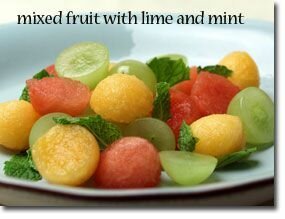If you don't know what to serve for dessert or a snack today ...
This is a great way to enhance the flavor of cantaloupe.

Ingredients:
- 1 cantaloupe
- 2 TBS fresh lime juice
- 4 mint leaves
- Cut cantaloupe in half and scoop out the seeds.
- Sprinkle each half with 1 TBS lime juice.
- Tear mint leaves by hand and sprinkle over cantaloupe.
In-Depth Nutritional Profile for Cantaloupe with Lime and Mint
Healthy Food Tip
The Latest News About Cantaloupe
The name "cantaloupe" actually comes from the name of a town in Italy near Rome called Cantaloupo in Sabina, where seeds were brought from Armenia and planted in the Papal gardens during the 1400-1500's.) Cantaloupes are members of the cucurbit family of plants (Cucurbitaceae) that also includes cucumbers, pumpkins, squashes, gourds, and a long list of melons. Melons in this same plant family with cantaloupe include Watermelon and honeydew melon, along with crenshaw, casaba, Persian, and canary melon. Because many members of the cucurbit plant family can easily cross-pollinate, there are also many different hybrid melons in the marketplace that combine features of true cantaloupe with features of these other melons.
What's New and Beneficial About Cantaloupe
- Because the flesh of the cantaloupe is often pastel-like in color (compared to the more vibrant color of fruits like oranges), we sometimes forget how important cantaloupe can be as a fruit source of vitamin A (in the form of carotenoids). Researchers have recently measured the carotenoid contents of six different California-grown cantaloupe hybrids and discovered that their beta-carotene content can reach levels as high as 3,138 micrograms (per 100 grams of fresh weight). That's about 30 times higher than the beta-carotene content of fresh oranges. Although this nutrient richness of cantaloupe still does not place it in the beta-carotene range for fresh carrots here (about 8,300 micrograms), it's still an aspect of this delicious fruit that is all-too-frequently overlooked.
- At first, we were disappointed in the outcome of a recent French study that put cantaloupe at the very bottom of the fruits list in terms of its polyphenol content. In this French study, fruits like strawberries, lychees, and grapes came out far better in their concentration of antioxidant polyphenols than cantaloupe, and no fruit scored lower in its concentration of polyphenols. But then we read about the total amount of polyphenols that cantaloupe contributed to the average daily diet. When looked at in this practical context, cantaloupe ranked higher than many other commonly eaten fruits, including kiwi, grapefruit, and clementines. It also ranked higher than watermelon and pineapple. Obviously, the higher volume of cantaloupe consumed helped to offset its lower polyphenol concentration. This practical principle is important to remember. A health-supportive, whole food like fresh cantaloupe may show up as being lower in its concentration of certain nutrients (including total polyphenols), but because we often eat it in serving sizes that are relatively large, we often get substantial nutrient benefits, even in the case of nutrients found in lower concentrations.
- Intake of cantaloupe has recently been found to lower risk of metabolic syndrome. In a study involving hundreds of women living and teaching in Tehran, Iran, the lowest risk of metabolic syndrome was found to occur in women who ate the greatest amount of fruit. (In this study, the "greatest amount" meant a minimum of 12 ounces per day.) Five fruits contributed most to total fruit intake: apples, grapes, cantaloupe, watermelon, and bananas. Women who consumed the largest amounts of these fruits were also determined to have the healthiest levels of C-reactive protein (CRP) in their bloodstream. CRP is an indicator very commonly used to assess levels of inflammation, and it's very likely that the anti-inflammatory phytonutrients in cantaloupe and other fruits contri buted not only to these participants' healthy levels of CRP but also to their decreased risk of metabolic syndrome.

No comments:
Post a Comment